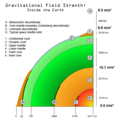Newton's law of universal gravitation
Newton's universal law of gravitation is a physical law that describes the attraction between two objects with mass. Sir Isaac Newton talked about it in his book Philosophiae Naturalis Principia Mathematica.[1][2] The law is part of classical mechanics.
The formula is
[math]\displaystyle{ F_g=G\frac{m_1 m_2}{r^2}, }[/math]
In this equation:
- [math]\displaystyle{ F_g }[/math] is the total gravitational force between the two objects.
- [math]\displaystyle{ G }[/math] is the gravitational constant.
- [math]\displaystyle{ m_1 }[/math] is the mass of the first object.
- [math]\displaystyle{ m_2 }[/math] is the mass of the second object.
- [math]\displaystyle{ r }[/math] is the distance between the centers of the objects.
In SI units, [math]\displaystyle{ F_g }[/math] is measured in newtons (N), [math]\displaystyle{ m_1 }[/math] and [math]\displaystyle{ m_2 }[/math] in kilograms (kg), [math]\displaystyle{ r }[/math] in meters (m), and the constant [math]\displaystyle{ G }[/math] is approximately equal to 6.674×10−11 N m2 kg−2.[3]
Newton's Law Of Universal Gravitation Media
References
- ↑ "Sir Isaac Newton: The Universal Law of Gravitation". Astronomy 161. Retrieved 2009-01-24.
- ↑ Cox, Brian; Forshaw, Jeff (2011). The Quantum Universe: Everything That Can Happen Does Happen. Allen Lane. p. 14. ISBN 978-1-846-14432-5.
- ↑ Mohr, Peter J.; Newell, David B.; Taylor, Barry N. (July–September 2016). "CODATA recommended values of the fundamental physical constants: 2014". Reviews of Modern Physics. 88 (3): 035009. arXiv:1507.07956. Bibcode:2016RvMP...88c5009M. doi:10.1103/RevModPhys.88.035009. S2CID 1115862.




